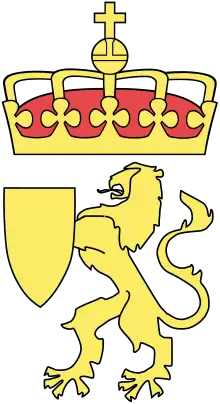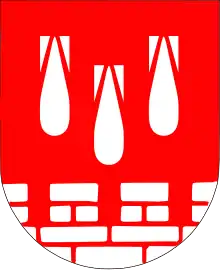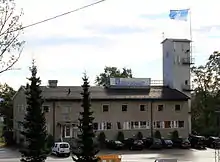Norwegian Civil Defence
Norwegian Civil Defence (Norwegian: Sivilforsvaret) is the civil defence organization of Norway.



The Norwegian Civil Defence sorts under the Norwegian Directorate for Civil Protection and Emergency Planning which again reports to the Ministry of Justice and Public Security. The organization is based on conscription where both men and women between the age of 18 and 55 can be called to serve. The Civil Defence are to support the police, fire departments, health care or other public agencies in case of larger incidents which those departments don't have the manpower to handle.
Organization

.jpg.webp)
_in_Troms%C3%B8_(2015).jpg.webp)
The Norwegian Civil Defence is split into.
- Peacetime Contingency Teams (FIG)
- Peacetime Contingency Teams - Personnel (FIG-P)
- Mobile Decontamination Units (MRE)
- Air Alert Service (LVG)
- Radiation measurement patrols (RAD)
As of 2016 the Norwegian Civil Defence has an operative force of 8000 men and women with duty to serve. In addition, a wartime reserve force of 8000 personnel will be trained and equipped should the need arise.[1]
Peacetime Contingency Teams (FIG)
The most active part of the Norwegian Civil defence. Each FIG contains 22 persons, one FIG leader and a second in command. The rest of the personnel are divided in two teams led by a team leader, and a second team leader. The FIG personnel are to respond to a call-out within one hour and there are 119 active teams in the country
Peacetime Contingency Teams – Personnel (FIG-P)
This is a release-reinforcement unit for the FIG. The personnel have exactly the same training as FIG. FIG-P have a call-out time of 30–60 minutes. Normally there is one Fig-P troop per FIG unit, divided in two teams.
Mobile Decontamiation Units (MRE)
There are 17 mobile clean-up units in the organization. Each group consists of 24 persons that are specially trained in decontamination of people that has been exposed to chemical, biological, or radioactive agents (CBRN).
The teams are equipped with a rapid deployable mobile decontamination unit that can be deployed at any site where chemical, biological or radioactive contamination had been detected.
Radiation Measurement patrols (RAD)
This is the smallest unit in the organization and consists of four personnel trained in measuring radioactivity. The unit measures background radiation at set locations and times for comparison. They are also trained in location radioactive materials.
There are 123 teams currently operating.
Ranks and rank insignia
| Rank insignia | Regular | National service | National service reserve |
|---|---|---|---|
 | Sjef for sivilforsvaret Director of Civil Defence | - | - |
 | Distriktssjef District Director | - | - |
 | Sivilforsvarsinspektør I Assistant Civil Defence Director I | - | Stabssjef Chief of Staff |
 | Sivilforsvarsinspektør II Assistant Civil Defence Director II | - | |
 | Sivilforsvarsadjutant I Chief Civil Defence Officer I | - | SF-sjefskontrollør Chief Controller Civil Defence Rådgiver stab Staff Adviser |
 | Sivilforsvarsadjutant II Chief Civil Defence Officer II | FIG-leder Peacetime Contingency Team Leader FIGP-leder Peacetime Contingency Team Leader - Personnel MRE-leder Mobile Decontamination Unit Leader IG-leder Contingency Team Leader STG-leder Support Team Leader | Seksjonsleder stab Section Leader Staff SF-kontrollør Civil Defence Controller LVG-skiftleder Air Alert Service Shift Leader |
 | Sivilforsvarsbetjent Civil Defence Officer | IG-nestleder Assistant Contingency Team Leader STG-nestleder Assistant Support Team Leader | Materiellforvalter Supply Officer Lege Medical Officer LVG-operatør Air Alert Service Operator Stabsmedlem Staff Member |
 | - | FIG-nestleder Assistant Peacetime Contingency Team Leader FIGP-nestleder Assistant Peacetime Contingency Team Leader - Personnel MRE-nestleder Assistant Mobile Decontamination Unit Leader | Kvartermester Quartermaster Sykepleier Nurse Sambandsleder Communications leader |
 | - | Squad Leader | |
 | - | Assistant Squad Leader Patruljeleder Patrol Leader Kvartermesterassistent Assistant Quartermaster | |
Source:[2]
History
The Norwegian Civil Defence was first founded as the voluntary air protection (Norwegian: Det Frivillige Luftvern) in 1936. It was later renamed to the civil air protection (Norwegian: Det Sivile Luftvern). The primary task for the organization was to protect civilians in case of war. This is also evident in the law from 1953 (Norwegian: Lov om sivilforsvar) that still governs the organization. Even so the organization has adapted to the change in threats against civilians.
See also
- Civil defense by nation
References
- "The Norwegian Civil Defence - Sivilforsvaret.no". www.sivilforsvaret.no. Retrieved 2016-05-12.
- Uniforms- og honnørreglement for Sivilforsvaret 2010 Retrieved 2016-11-27.
External links
| Wikimedia Commons has media related to Norwegian Civil Defence. |